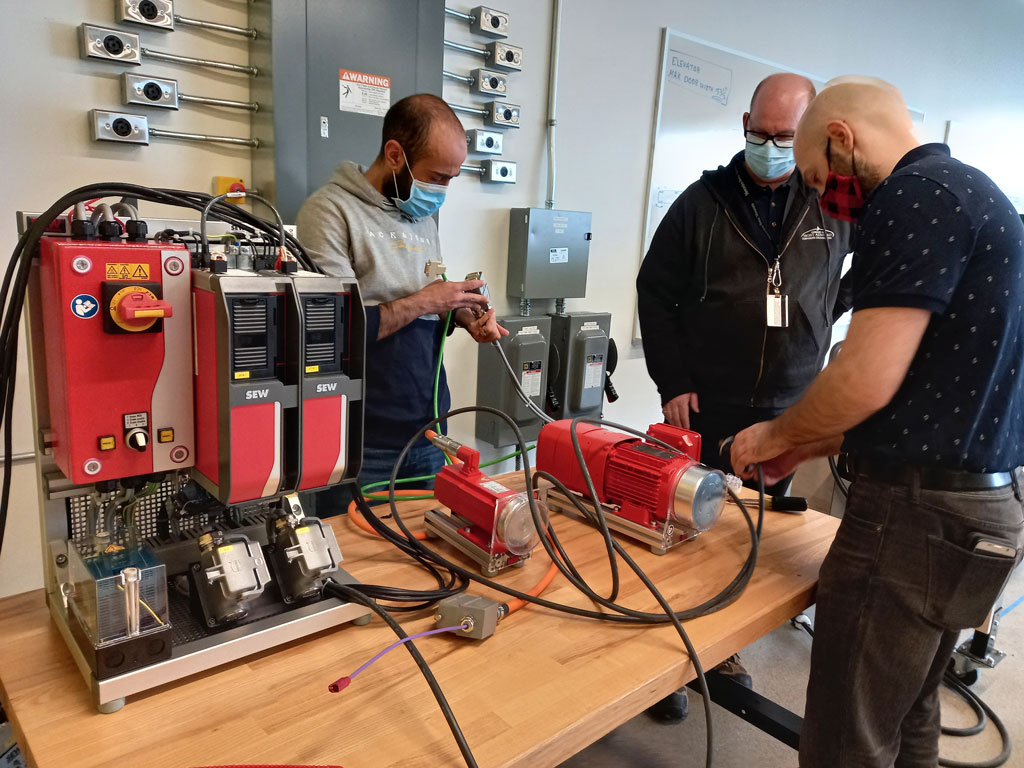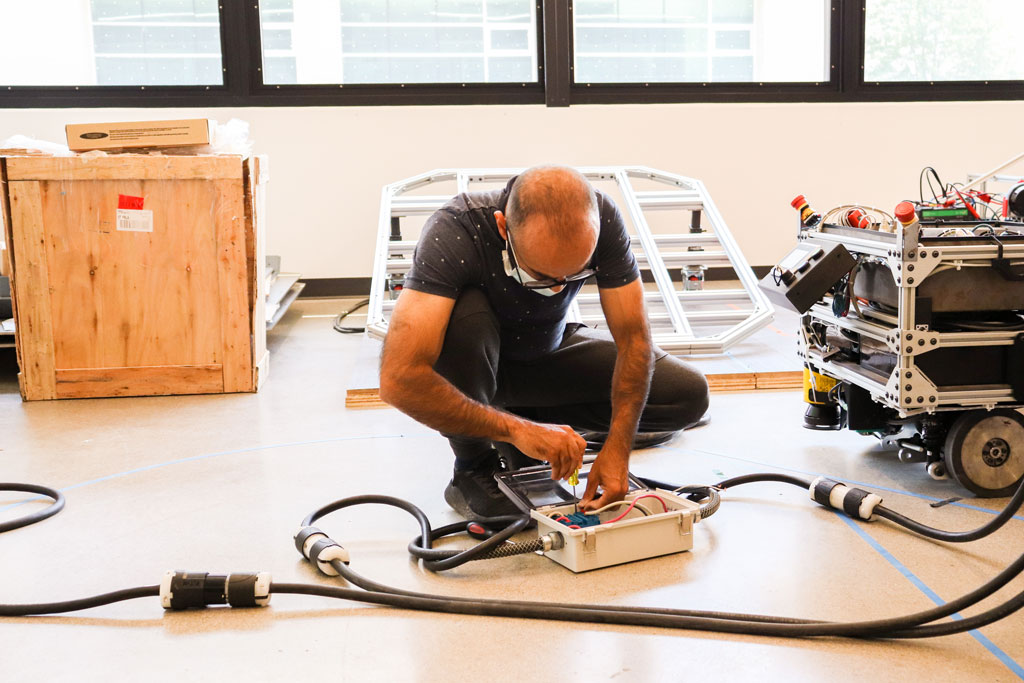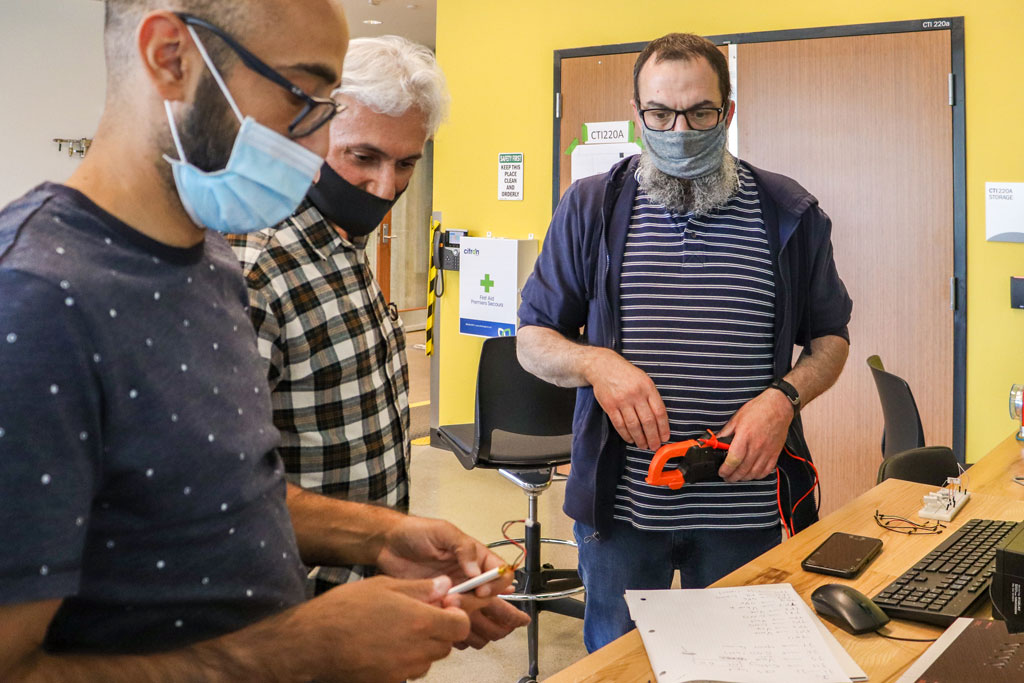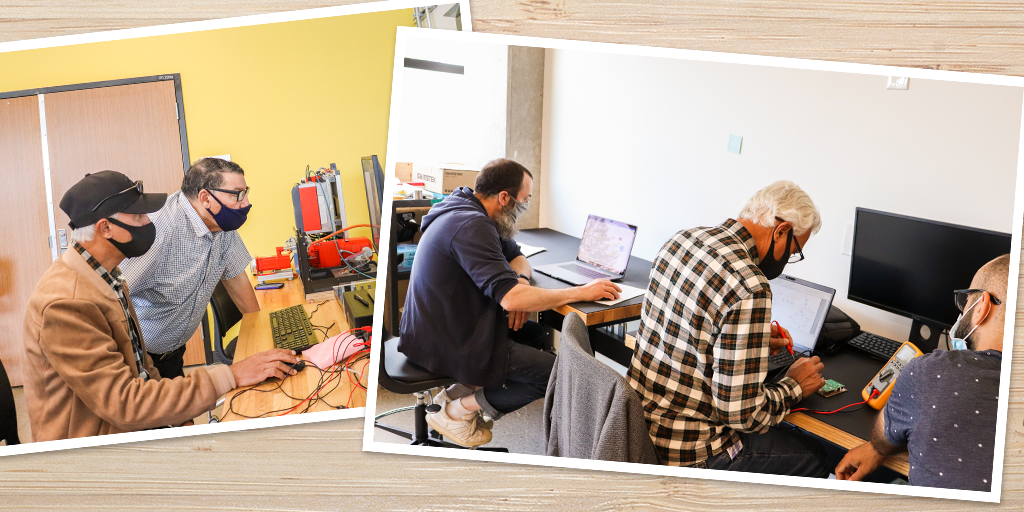Researchers at the Faculty of Applied Sciences and Technology (FAST), with the sponsorship of SEW-EURODRIVE, worked in a project collaboration space at the Barrett Centre for Technology Innovation at Humber College to design a CT-based energy harvesting circuit that powers an SEW-EURODRIVE sensor board used for three-phase AC motors condition monitoring. This project was supported and partially funded by Humber’s Office of Research and Innovation.
Industry 4.0 technologies and its applications, including Internet of Things (IoT), automation and data technologies, can help organizations and businesses better prepare and navigate the unprecedented challenges heightened by the current pandemic. Reinventing and repurposing internal operations to meet industry demands is crucial for survival. Humber College continues to collaborate with industry partners to provide valuable contributions, where industry partners gain access to Humber’s research excellence and Centres of Innovations like the Barrett CTI while providing Humber with an opportunity to contribute to innovative breakthroughs and real-life industry exposure for researchers and students.

Industry Partner and the collaborative work with the Barrett CTI
In 2018, Humber College and SEW-EURODRIVE entered a five-year partnership agreement designed to build awareness and provide training and applied research opportunities related to Industry 4.0 technologies, a critical aspect of advanced manufacturing.
“Humber has a long-standing relationship with SEW-EURODRIVE and together we entered into this official partnership, in part, to work on projects just like this. It’s about creating meaningful hands-on experiences working on real-world business challenges in collaboration with faculty and industry. I am very pleased with the end result of this project with the possibility of more to come.” – Neal Mohammed, Director, Barrett CTI
SEW-EURODRIVE is a leading global manufacturer of innovative drive technology and a pioneer in drive-based automation, boasting 90 years of expertise in supplying drive systems. SEW-EURODRIVE in Canada was established in 1974. Its outstanding success and expansion across Vancouver, Toronto and Montreal demonstrates the organization’s ability to offer leading expertise that solves industry challenges in power transmission and motion control.
SEW-EURODRIVE is a member of Humber’s Advanced Manufacturing Skills Consortium. The Barrett CTI houses this consortium, a group of nine leading industry partners working with Humber College to train students and employees of Canadian companies and support many applied research projects with diverse partners across multiple sectors. Humber is transforming learning by converging industry, community, and education to find innovative solutions to real-world problems.
“The value that we saw in SEW-EURODRIVE partnering with Barrett CTI and Humber was that we saw some innovation happening …; we’re more interested in the applied research on how we can help our customers who buy our products. We’ve had many years where we would be trying to sell them some super advanced automation solutions, and our customers simply were not ready. Now this gives us the opportunity to leverage the CTI with our products, and with our solutions, educate our customers and educate the school as well and even educate ourselves.”
– Lyall Watson, Sales Manager, SEW-EURODRIVE Canada“There’s a huge need for higher skillset in the workforce, and getting to garner and develop that with Humber is going to be a huge step for us as we’re looking for new employees or students coming into the workforce.“
– Rainer Blickle, Vice President, SEW-EURODRIVE USA

Research Challenge
At the Faculty of Applied Science and Technology at Humber College, with the sponsorship of SEW-EURODRIVE, a project was developed in order to explore the prospect of harvesting energy from prevailing machines to power monitoring electronics.
Energy harvesting is the process of capturing energy from other prevailing high-power machines that are in operation. For example, energy can be harvested from the heat emitted by the machine using a thermal energy generator (TEG) device, through vibration and elevated levels of sound of the machine using a piezoelectric device, through electromagnetic induction of the machine’s power lines using current transformers (CTs) surrounding the power line, and through many other innovative methods that have been established and are constantly being built upon.
These methods are desirable not only because the harvested energy is free of charge but because they help in avoiding direct contact with the high voltage input line terminals compared to the conventional method of using step-down transformers to generate the required energy at low voltage levels. For this reason, energy harvesting power supplies can be added to the old systems easily with minimum modifications, less risk and faster time. Additionally, they require low maintenance efforts and lower cost.
Three Stages of the Project led by the Research Team

The methodology used in achieving the goal was to divide the project into three parts:
- Identify Challenge:
The challenge in using CTs to harvest energy is that the input line current of the motor changes with the mechanical load on the motor’s shaft. The power demand of the load also changes randomly during the operation of the system. Furthermore, when small three-phase motors are used, the input line current becomes proportionally small regardless of the mechanical load, which makes energy harvesting even harder. - Design:
To overcome the challenges above, an accurate model for the CT feeding power solution had to be designed. When the research team realized they did not have all the parts they needed, they reached out to local suppliers for assistance. Hammond Manufacturing offered to provide the materials free of charge. Hammond Manufacturing was interested in the research and provided a second transformer that helped the team test the one they designed. Also, the fluctuating current source from the motor was addressed with a method of compensation to maintain a constant 5V/1.75W output. - Test Results:
Test results proved that the circuit was able to harvest 1.75 watts from three-phase line currents. The size of the printed circuit board (PCB) is acceptable; however, more work is required to reduce the size of the current transformers. Moreover, the number of primary turns on the current transformers have been increased to 12 to harvest the same amount of energy from the SEW 1kW motor. If one turn primary CT is to be used, the CT design should be upgraded.
The circuit was designed to harvest energy from current transformers only; however, other ways of energy harvesting should be considered in the future, such as solar, heat and vibration energy. Texas instruments boost regulator was used in this design; however, other high-quality boost regulators are available by other manufacturers, like Analog Devices or Maxim, to be considered in future designs. The research team did not build just an energy harvesting PCB in this project but also established a complete energy harvesting test setup at Humber College that can be used for future projects and developments in this growing field.

The Research Team
Hussin Hassen, Professor of Electrical Engineering, MASc., P.Eng., Faculty of Applied Sciences and Technology, led the project as Research Team Leader. The research team collaborated and utilized the state-of-the-art technology and facilities within a project collaboration space at the Barrett CTI.
Hassen has 24 years of experience in industrial organizations. As a professor at Humber College since 2013, Hassen has taught courses on power electronics, electric machines, electric power systems analysis, electric power generation and industrial electronics. He has developed new lab experiments and online courses. Hassen has successfully acquired a patent with other co-inventors for: “System, Computer Program and Method for Providing Energy Hub”—a new method for an energy hub management system based on mixed integer linear optimization programming. Hassen is a member of Professional Engineers Ontario (PEO).
“The solution we provided is to harvest energy from the magnetic field surrounding the transformer. This is a touchless power supply that won’t touch the high voltage line. This can make modifications easier, safer and even cheaper.” –Hussin Hassen, Research Team Lead
Hassen asserts that not only are Humber students getting excellent, hands-on experiences, but the college itself also benefits from the project.
“We now have a complete lab to use for future projects in this field. If the company wants us to continue making improvements or developments, we can definitely help. We have the knowledge, and we have the components. We made the prototype, solved the problem, and now the company will decide if they ever want to commercialize, or mass-produce this design or not.” –Hussin Hassen, Research Team Lead

Student Gains
Two Research Assistants were hired from Humber’s Electrical Engineering Control Systems Program:
- Abgar Lagin, Electrical Engineering Technologist
“I’m always up for a challenge, and I was eager to learn and be involved in such a project. The most difficult part was conducting research. There wasn’t much to read about on the Internet, so this definitely pushed me to learn more about it. The experience was a lifetime opportunity. It was a pleasure to be part of Professor Hassen’s team and the Barrett CTI team.” - Eliseu Marcos, Electrical Engineering Technologist
“I had an opportunity to apply what I learned at Humber and that was very rewarding. From theory to real life application was an enriching experience especially under one of my amazing professors that I had the pleasure to learn from in various courses in the Electrical Engineering program.”
The students/research assistants were able to:
- acquire hands-on training through the design of the CT-based energy harvesting circuit,
- get an opportunity to perform literature review under the guidance of supervisors,
- train as independent workers and critical thinkers through all phases of the project,
- interact with industry professionals, and
- gain exposure to emerging trends and technologies in an industrial setting.
Acknowledgments
The research team would like to thank SEW-EURODRIVE, particularly Frank Hartmann, Michael Gutmann, Lyall Watson, and Ogi Ruzic; the Barrett Centre for Technology Innovation, namely Director Neal Mohammed, technologists Anthony Nyman and Angelo Mecollari as well as project coordinator Temu Moore; and the Faculty of Applied Sciences and Technology’s Vlad Porcila and Khaled Ibrahim for their help, support, and encouragement throughout the process of research and creation.
“Applied research projects such as these sums up perfectly what we strive to do here at the Barrett CTI: solving pertinent industry challenges, bringing together interdisciplinary project teams of students, faculty and industry. Starting with the end goal in mind, it’s always rewarding for all the stakeholders to see the development of the project as it goes through its lifecycle. The students were very keen, very interested to learn. Developing solutions to the challenges presented is not something they would be learning in school directly, so they had additional exposure to current issues and emerging trends.” –Temu Moore, Project Coordinator
The success of research projects is an outcome we are enthusiastic about sharing with our audience. Expect regular updates from us highlighting breakthroughs through research and innovation. In the meantime, we want to hear from you. What are some of the projects you are leading? Get involved with Humber’s Office of Research and Innovation
Definitions
- The Internet of Things (IoT—also referred to as Industry 4.0 or Smart Production) is the rapidly-growing network of machines, appliances, systems, and devices that feature internet connectivity. Equipped with sensors, they are controlled remotely and result in improved efficiency, accuracy, and economic benefits.
- Industry 4.0 technologies are the devices connected to the Internet of Things. These could include “smart” manufacturing machines that monitor, through advanced sensors, everything from productivity levels to atmospheric changes that might impact the manufacturing process.
- Drive systems are the mechanisms used to power vehicles and other machines through motors. In cars, for example, there are automatic and manual drive systems, and also 2-wheel or 4-wheel drive systems.
- Drive-based automation is being increasingly used in large manufacturing as this type of automation allows the system itself to be “intelligent” and self-regulate (instead of controller-based automation, in which an outside source, such as an operator, has to input data to tell the machines what to do).
- CT-based energy harvesting circuits (EHCs) power the monitoring sensors in these drive systems. As with the drive systems themselves, CT-based EHCs have the ability to self-regulate, managing electricity flow, and identifying irregularities.
Photo Credits
- Photos of project team provided by Temu Moore, Project Coordinator, Barrett Centre for Technology Innovation, Humber Institute of Technology & Advanced Learning
- Illustration: Shutterstock/elenabsl
